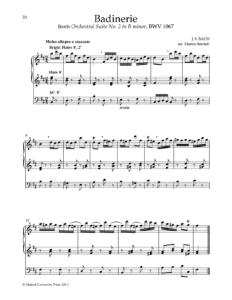Bach Piano Transcriptions
Piano Transcriptions
When I think of Bach piano transcriptions, I’m not talking about Bach’s original compositions. What I’m thinking of are arrangements of works for various instruments including the organ, violin, cello, viola, harpsichord, oboe, flute, clarinet, and bassoon. Some of the Bach transcriptions are very exuberant, and others are surprisingly gentle. These arrangements reveal more about the transcriber than the original work itself. For example, there are the “anti-transcriptions” by Andrew Manze, who reconstructed hypothetical versions of Bach’s Toccata and Fugue in D minor for organ.
Aside from the more obvious transcriptions of chorales, there are also Bach’s famous “Trio” and “Sinfonia for Strings” movements. Both are included in the Bach Transcriptions for Piano album. They are also accompanied by introductory notes by David Owen Norris. Despite their popularity in the early 20th century, most of these transcriptions aren’t actually transcribed from the original works.

The Bliss Piano Concerto was originally recorded for EMI in the 1960s. It has since been reissued on Diversions DDV 24106. However, the original recording is not included in this edition. Similarly, the Complete Bach Transcriptions for Solo Piano includes only six of Bach’s organ preludes and fugues. This means that there aren’t many Bach transcriptions of this quality available on the market.
Bach Piano Transcriptions
Although the Bach Transcriptions for Piano album is not the most technically advanced or complex recording out there, it’s a great place to start. For instance, Ignoz Friedman’s version of the D minor Toccata and Fugue isn’t much more than a standard piano transcription, but it’s still a worthwhile effort. While it’s less orchestral than Busoni’s transcription, it does the trick, allowing the player to move from register to register easily. Moreover, it’s a great ode to the piano’s capabilities.
For a different take on the same music, Ignoz Friedman’s transcription of the BWV1027, which is a three-movement arrangement of a lost sonata, is a worthy listen. His articulation and control of double notes are impressive, and his approach to rhythmic counterpoint is refreshing. Another notable mention is that he’s playing on a Bluthner, a renowned piano from the 19th century that boasts a flinty tone at loud moments.
In the process of tracing Bach’s musical journey, we’re able to appreciate the masterful way the composer adapted his works for various instruments. From the cantata Ich hatte viel Bekummernis, which he arranged into the first movement of the Trio Sonata No. 4, to the Canonic Variations on “M Himmel hoch da komm’ ich her”, which he arranged for 23 players in 1956, we’re treated to a fascinating look at the way a genius can make music out of very little.
One of the most significant Bach transcriptions for the piano is the “Trio” movement, which is an arrangement of the composer’s Sonata in G minor for oboe, harpsichord, and two violins. Although the original is thought to have been for a viola da gamba and obbligato harpsichord, this arrangement is more a work for an orchestra.